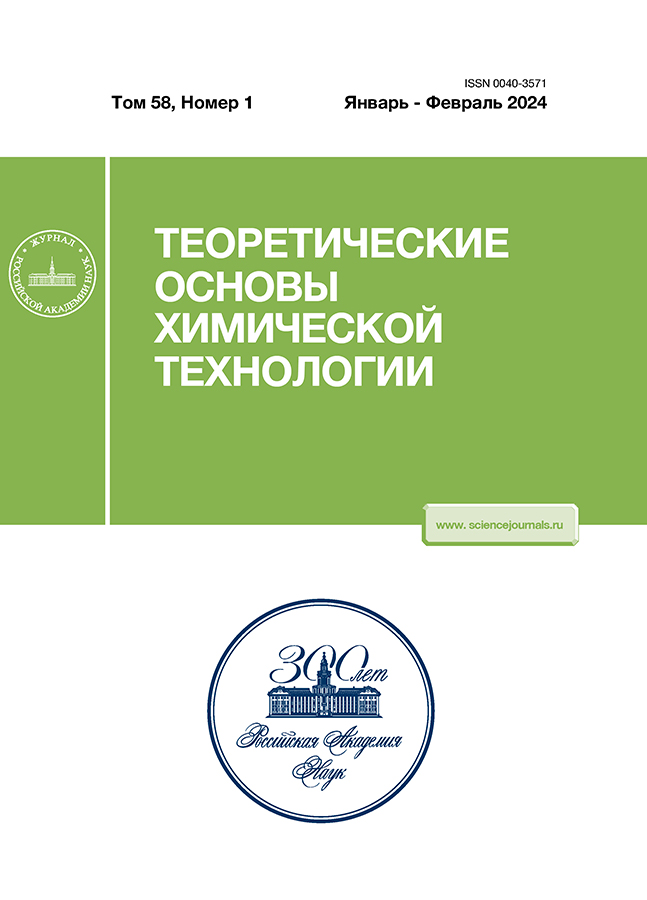Процессы ионного обмена на катионите Н+ для снижения жесткости воды
- Авторлар: Клинов А.В.1, Разинов А.И.1, Прокопович А.Е.2, Саблин Е.В.2
-
Мекемелер:
- Казанский национальный исследовательский технологический университет
- ООО “АкваБрит”
- Шығарылым: Том 58, № 1 (2024)
- Беттер: 17-26
- Бөлім: Articles
- ##submission.datePublished##: 21.07.2024
- URL: https://j-morphology.com/0040-3571/article/view/652824
- DOI: https://doi.org/10.31857/S0040357124010038
- EDN: https://elibrary.ru/ZFLXNS
- ID: 652824
Дәйексөз келтіру
Аннотация
Рассматривается процесс ионообмена на катионите Н+ в картриджах для умягчения воды. Предлагается математическая модель этого процесса, содержащая два настраиваемых параметра, один из которых связан со свойствами катионита. Идентификация параметров модели и проверка ее адекватности осуществлялась по собственным экспериментальным данным. Результаты моделирования позволили выявить ряд особенностей протекания процесса изменения жесткости воды на катионитах Н+, которые будут полезны при решении проектных и поверочных задач в области ионообменных процессов и аппаратов для умягчения воды.
Негізгі сөздер
Толық мәтін
Авторлар туралы
А. Клинов
Казанский национальный исследовательский технологический университет
Хат алмасуға жауапты Автор.
Email: alklin@kstu.ru
Ресей, Казань
А. Разинов
Казанский национальный исследовательский технологический университет
Email: alklin@kstu.ru
Ресей, Казань
А. Прокопович
ООО “АкваБрит”
Email: alklin@kstu.ru
Ресей, Москва
Е. Саблин
ООО “АкваБрит”
Email: alklin@kstu.ru
Ресей, Москва
Әдебиет тізімі
- Crittenden J.C., Trussell R.R., Hand D.W., Howe K.J., Tchobanoglous G. MWH’s Water Treatment: Principles and Design. 3rd ed. John Wiley & Sons, 2012. P 1920.
- Vecino X., Reig M. Wastewater treatment by adsorption and/or ion-exchange processes for resource recovery // Water. 2022. V. 14. P. 911. https://doi.org/10.3390/w14060911
- Sirajudheen P., Karthikeyan P., Ramkumar K., Meenakshi S. Effective removal of organic pollutants by adsorption onto chitosan supported graphene oxide-hydroxyapatite composite: A novel reusable adsorbent // J. Mol. Liq. 2020. V. 318. https://doi.org/10.1016/j.molliq.2020.114200.
- Parsons S.A. The effect of domestic ion-exchange water softeners on the microbiological quality of drinking water // Water Res. 2000. V. 34, Is. 8. P. 2369–2375. https://doi.org/10.1016/S0043–1354(99)00407–8
- Al-Sheikh F., Moralejo C., Pritzker M., Anderson W. A., Elkamel A. Batch adsorption study of ammonia removal from synthetic/real wastewater using ion exchange resins and zeolites // Sep. Sci. Technol. 2021. V. 56. № 3. P. 462–473. https://doi.org/10.1080/01496395.2020.1718706
- Bashir A., Malik L.A., Ahad S. et al. Removal of heavy metal ions from aqueous system by ion-exchange and biosorption methods // Environ Chem. Lett. 2019. V. 17. P. 729–754. https://doi.org/10.1007/s10311-018-00828-y
- Dixit F., Dutta R., Barbeau B., Berube P., Mohseni M. PFAS removal by ion exchange resins: A review // Chemosphere. 2021. V. 272. P. 129777.
- Simonič M. Reverse osmosis treatment of wastewater for reuse as process water – a case study // Membranes. 2021. V. 11. P. 976. https://doi.org/10.3390/membranes11120976
- https://aquabrit.ru/
- https://horecawater.ru
- https://www.tokem.ru/ru/
- Sachin N., Jayshri V., Shilpi K., Amit B., Tapan C., Rajesh B. Equilibrium isotherm and kinetic modeling of the adsorption of nitrates by anion exchange Indion NSSR resin // Desalination. 2011. V. 276. № 1–3. P. 38–44. https://doi.org/10.1016/j.desal.2011.03.015
- Chabani M., Amrane A., Bensmaili A., Kinetic modelling of the adsorption of nitrates by ion exchange resin // Chem. Engin. J. 2006. V. 125. № 2. P. 111–117, https://doi.org/10.1016/j.cej.2006.08.014
- Judith K., Reinhold C., Dietmar R. Adsorption and ion exchange: basic principles and their application in food processing // J. Agricult. Food Chem. 2011. V. 59. № 1. P. 22–42 https://doi.org/10.1021/jf1032203
- Montes P., Abeywickrama J., Hoth, N., Grimmer M., Drebenstedt, C. Modeling of ion exchange processes to optimize metal removal from complex mine water matrices // Water. 2021. V. 13. P. 3109. https://doi.org/10.3390/w13213109
- Boyer T., Miller C., Singer P., Advances in modeling completely mixed flow reactors for ion exchange // J. Environ. Eng. 2010. V. 136. № 10. P. 1128–1138. https://doi.org/10.1061/(ASCE)EE.1943–7870.0000241
- Hwang S., Lu W. Ion exchange in a semifluidized bed // Ind. Eng. Chem. Res. 1995. V. 34. № 4. P. 1434–1439. https://doi.org/10.1021/ie00043a052
- Hekmatzadeh A., Karimi-Jashani A., Talebbeydokhti N., Kløve B., Modeling of nitrate removal for ion exchange resin in batch and fixed bed experiments // Desalination. 2012. V. 284. P. 22–31. https://doi.org/10.1016/j.desal.2011.08.033
- LeVav M., Carta G. Perry’s Chemical engineers’ handbook: adsorption and ion exchange. McGraw-Hill Professional: New York, 2007.
- Рудобашта С.П. Массоперенос в системах с твердой фазой / Под ред. А.Н. Плановского. М.: Химия, 1980. 248 с.
- Шервуд Т., Пигфорд Р., Уилки Ч. Массопередача / Пер. с англ. М.: Химия, 1982. 696 с.
- Helfferich F. Ion Exchange. Dover Publications: New York, 1995.
- Дьяконов С.Г., Разинов А.И. Описание изобарно-изотермической диффузии в идеальных жидких смесях // Теорет. основы хим. технологии. 1982. Т. 16. № 1. С. 105.
- Klinov A., Anashkin I. Diffusion in binary aqueous solutions of alcohols by molecular simulation // Processes. 2019. V. 7. № 12. P. 947. https://doi.org/10.3390/pr7120947
- Антропов Л.И. Теоретическая электрохимия. 4-е изд., перераб. и доп. М.: Высш. школа, 1984. 519 с.
- Рид Р., Праусниц Дж., Шервуд Т. Свойства газов и жидкостей / Пер. с англ. 3-е изд., перераб. и доп. Л.: Химия, 1982. 592 с.
- https://www.mathcad.com/en/
- Butler J. N. Carbon dioxide equilibria and their applications. Lewis Publishers, 1991. 272 p.
- https://www.msulab.ru/
Қосымша файлдар

















